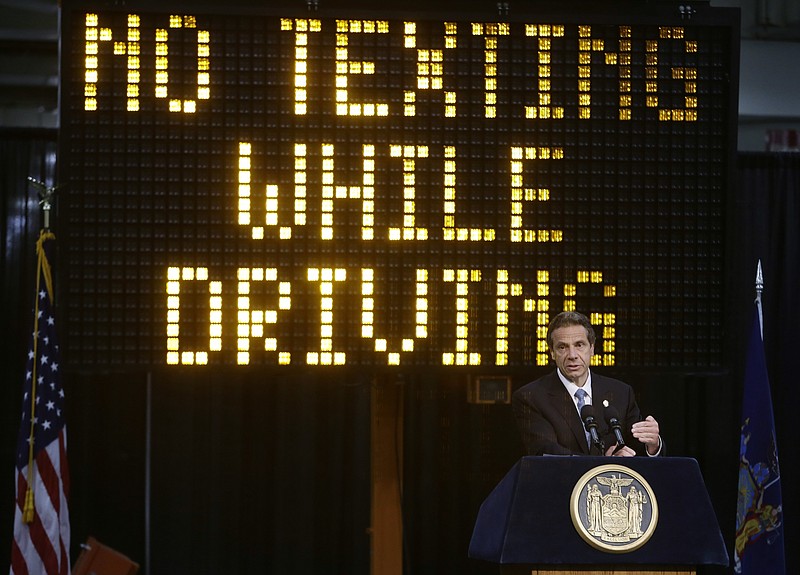Bans on handheld phone use while driving are among the most effective ways of preventing fatal crashes that occur because of distracted driving, according to a report by the American Academy of Pediatricians.
The organization compiled data stretching from 2007-17 involving drivers ages 16-19. During that period, there were 38,215 fatal crashes involving those drivers.
Incidents of fatal crashes were highest for 19-year-old drivers and lowest for 16-year-old drivers.
"States with primarily enforced texting bans had lower motor vehicle crash fatality rates overall involving 16- to 19-year-old drivers," the report found. "Texting bans and handheld bans for all drivers were associated with decreased motor vehicle crash fatalities in all ages."
States with bans on all handheld devices had the greatest reduction of fatal crashes.
Widespread public health programs and efforts led to a sharp decline in motor vehicle fatalities during the past two decades, according to the report, "Distracted Driving Laws and Motor Vehicle Crash Fatalities."
However, the mortality rates have been increasing since about 2013, it says.
The increases have coincided with the rising use of technology and mobile devices, contributing to distracted driving.
Nearly 4,000 children ages 0-18 died in crashes in 2016. Those crashes accounted for 20 percent of all U.S. pediatric deaths, according to the report.
The higher crash rates have been attributed to a number of factors, the report says, including inexperience, risk-taking and driver distraction.
To improve youth driving experience, all 50 states have implemented graduated driver licensing laws. These laws allow full, unrestricted licensure for drivers younger than 18 only after a predetermined "learner period," with a supervised driver.
The learner period is typically followed by an intermediate stage that may include restrictions on nighttime driving and passengers.
The effectiveness of the graduated licensing laws varies from state to state, depending on their provisions.
The majority of states also have additional laws intended to improve motor vehicle safety, including seatbelt laws, penalties for impaired driving and reduced highway speed limits. These laws have proven to be effective in reducing crash fatalities for nearly all drivers.
"More-recent legislative efforts have focused on restrictions on the use of cellphones with the goal of decreasing driver distraction, including text messaging bans, handheld cellphone bans, and novice driver all-cellphone-use bans," the report says. "Distractions while driving can come in several forms, including texting on a mobile device, talking on a cellphone, and other tasks requiring drivers to look away from the road and at the device."
Studies have shown texting can lead to decreased reaction time, less control of vehicle stability and elevated injury risk to vehicle occupants and pedestrians. Multiple studies, the report says, have shown distracted driving causes an increased risk of crash to all drivers, particularly teenagers.
"This risk is present even when not physically looking away from the road because cognitive distraction from conversing on a phone can also increase crash risk," it says. "Most concerning is that nearly half of all U.S. high school teenagers older than 16 years reported texting while driving in the past 30 days."
Despite recent studies having found an apparent correlation between states' laws and reductions in traffic fatalities, researchers remained unclear of the connection between cellphone use and teenage fatalities, the report says.
However, the Academy of Pediatrician study looks at data for longer periods than most other research.
Its 11 years of data cover a time when the number of states with distracted driving laws increased from 15 (in 2007) to 47 (in 2017). During the period, the rate of fatal crashes involving adolescents decreased by about a third.
Missouri was among states that implemented new laws during that period. It passed a law that made it illegal for anyone younger than 21 from texting and driving.
Critics of the law said it should be universal.
When Missouri passed the law, it became only the ninth state to single out a particular age group for the violation.
"As rates of motor vehicle crash fatalities are rising in teenagers, advocating for and implementing effective primary legislation banning handheld cellphone use for all ages will be an important part of reversing this trend," the report says. "Additionally, practitioners caring for adolescents should continue to counsel on the dangers of driving while distracted to aid in awareness of this important cause for injury and death."

